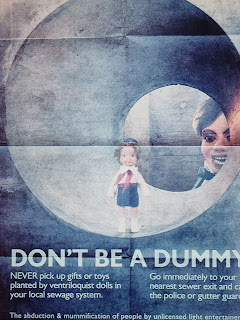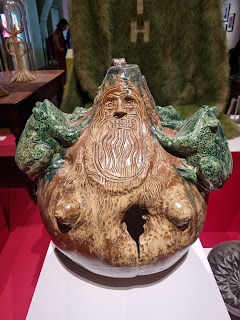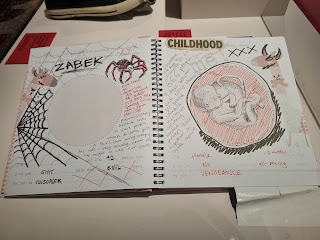"Where there is no imagination, there is no horror" - Arthur Conan Doyle
Noel Fielding - Post Viral Fatigue (2022)
Some people don't like horror movies. They find them too scary. They give them nightmares. But even though Somerset House's current exhibition is called The Horror Show and is divided up into three section titled monsters, ghosts, and witches it seems very unlikely you'll shudder, scream, or feel a chill going down your back at any point during your visit.
That's because The Horror Show doesn't feature vampires, werewolves, Michael Myers, or even that moron Freddy Krueger. It doesn't even feature Dracula, Frankenstein's Monster, the Mummy or Leatherface. It is more focused on what we tend to call 'folk horror' these days and it drills down deeper into how the horrors of the everyday world, the real horrors, are replicated in art, film, music, and the stories we tell each other. You won't get round the show without pondering the meaning of the word 'liminal'.
To get you in the mood, you enter Somerset House through a doorway mocked up to look like a large mouth, complete with fangs - of course, and once you're in the show proper you walk down an aisle with some kind of deconstructed face in front of you. It reminded me both of Hitchock's Spellbound and of Polanski's Repulsion.
Once you're in the show proper you are accompanied, most of the way round, by music of some description. Starting with an early, dub reggae influenced recording of Bauhaus' Bela Lugosi's Dead and moving on to excerpts of Barry Adamson's Moss Side Story, Mica Levi's soundtrack to Under The Skin, and Gazelle Twin's We Wax, We Shall Not Wane. An audio installation that includes excerpts from Agnes Sampson's Healing Charm from 1591. Sampson being the first woman executed under the witchcraft act.
The show is laid out in a roughly chronological fashion and it starts about fifty years ago with David Bowie in his Diamond Dogs area. It talks briefly about how ideas of horror started to be used by artists not to just scare and excite people but to challenge the status quo, to question established orthodoxy.
How in the darkest of times we look to alternative realities to help us face very real horrors. As it says on a sign in the first room, to help us "embrace the unknown and radically reimagine the world around us". That's certainly true of Bowie and it's true, also, of some of the punk culture he inspired.
Linder - Untitled (1976)
Luciana Martinez de la Rosa - Jordan (1977)
Bowie, and the punks that followed in his wake, had seen the idealistic dreams of the 1960s come to nothing, they'd seen Britain in the seventies enter a period of economic turmoil, and they'd seen just how deeply entrenched establishment power was. In many ways, it was a lot like now. People were desperate for change and went to extreme measures to get it.
Much of it came in the form of creative pursuits. There was Linder's cut and paste artworks, Sue Webster's self decorated leather jacket (although that seems to come from the last few years so perhaps inspired by that time rather than of it) and there were the books of Richard Allen, William S.Burroughs, and Anthony Burgess. There's examples of all of that on show alongside letters from Honey Bane, Barney Bubbles designed NME covers, sketches by Poly Styrene of X-Ray Spex and posters for The Rocky Horror Show.
Sue Webster - Helter Skelter leather jacket (2019)
Chris Kumari Burman - If There Is No Struggle, There Is No Progress (1981)
From the SEX boutique on Kings Road (created by Vivienne Westwood and Malcolm McLaren) and the nearby Acme Attractions (run by Don Letts), punk took a stand against straitlaced, conventional, backwards looking British society. If some of the music was simply poorly played pub rock or rock'n'roll covers to begin with that soon changed as bands like Public Image Ltd, Wire, The Fall, and Throbbing Gristle came through the doors kicked down by punk with a whole new agenda.
At The Horror Show you can see Poly Styrene's infamous helmet, Marc Almond artworks, Dennis Morris prints of early PiL, a copy of The Normal's Warm Leatherette, Daniel Miller from that band's copy of J.G.Ballard's Crash, collections of John Cooper Clarke's poetry, Jake and Dinos Chapman artworks, and an image of, and by, Marc Almond in which he illustrates just how frightening he finds the future.
Marc Almond (with Jamie McLeod) - The Future's Frightening (2016)
Some of these works are from the late seventies, others have been made in the last ten and fifteen years, but they're all inspired by the punk energy that first took hold of (some parts of) Britain nearly fifty years ago. But punk was a short sharp shock and it soon diffused into many different youth movements.
The curators of The Horror Show are, understandably, less interested in the new romantics than they are in the goths and, even more so, those that would come to be considered as makers of industrial music. As Margaret Thatcher cast her long shadow over the UK, as the Falklands War and the miner's strike took place, this music seemed a perfect soundtrack to a splintered and bedevilled Albion.
Graham Dolphin - Door (Joy Division Version) (2012)
Alongside Graham Dolphin's remaking of the door from Joy Division's Love Will Tear Us Apart video and photos to promote Steel Pulse's Ku Klux Klan, you can ponder copies of The Specials' Ghost Town as well as records by Nurse With Wound, Current 93, Cabaret Voltaire, and Linton Kwesi Johnson. There are Jamie Reed collages, copies of Class War magazine, and even Margaret Thatcher's Spitting Image puppet. Put together, it creates an image of a Britain I remember only too well.
Class War (1987)
Margaret Thatcher puppet from Spitting Image (2020)
Helen Chadwick - Allegory of Misrule (1986)
Tim Noble & Sue Webster - Bloody Haemorrhaging Narcissus (2009)
Jake and Dinos Chapman - Return of the Repressed (1997-2007)
Harminder Judge - Self Portrait (after Kali & Gene) (2009)
There's other stuff in the show that seems to be there simply because it either looks cool, freaky, or, in some way gruesome and that's fine. That seems to be in keeping with the ethos of both horror and of the countercultural movements that utilised horror tropes to their own ends.
Some of it, like the models and the images of the goth punters at the Batcave below, wasn't even labelled up. They're in a room, along with photos by Derek Ridgers and video footage of Leigh Bowery, that explores how, during the post-punk era, personal identity was explored and new looks were often flaunted in nightclubs with names like Kinky Gerlinky, Taboo, Pleasure and Blitz. I was too young to go to any of these nightclubs but a few years later I was hanging round with a bunch of punks, goths, and industrial music fans and one of them, on the periphery of my social scene, was Andrew Liles so it was quite a pleasant surprise to see one of his, very bright, works exhibited in The Horror Show.
Andrew Liles - Day-Glo-Djehonokama
Monster Chetwynd - Hybrid Creature Bat (2019)
Moving into the 1990s, Britain (and the rest of the world) was becoming ever more reliant on the Internet, the information superhighway, and data surveillance was starting to become a concern. A large dome appeared on the Greenwich peninsula as if an alien spacecraft had touched down in London. The future, as ever, was uncertain and some sought solace in nostalgia. You may remember television shows like I Love 1984.
Things were ever thus though. In the seventies, we'd watch Happy Days or even The Good Old Days. But as the millennium turned, and following 9/11, we entered a new age of anxiety with George W Bush and Tony Blair's ill advised, and lethal, War on Terror. Afghanistan and Iraq have still not recovered. Arguably nor has the UK.
Robin Rimbaud, under the name Scanner, intercepted radio communications and incorporated them into his music, other musicians (Burial, The Caretaker, Philip Jeck) created a loosely defined genre called hauntology that evoked shared cultural memories of library music, TV soundtracks, and public information films. Richard Littler's brilliantly satirical Scarfolk series came from the same world. It imagined the leaflets, festivals, and habits of the inhabitants of a fictional Norfolk town stuck in an endless cultural 1970s loop.
Omnidirectional scanner antenna and YUPITERU MVT-17000 scanner (1993)
Richard Littler - Poster from 'Scarfolk' series (2013-2021)
AKAI S950 Sampler (1988-93)
Iain Sinclair - Hand drawn map reproduced in 'Lud Heat' (1975)
You can see the AKAI sampler that A Guy Called Gerald used to capture Nicola Colliers' vocals on 1989's acid house classic Voodoo Ray, Iain Sinclair's hand drawn map of Nicholas Hawksmoor's churches of London (the ones he has suggested harbour occult forces and which you can read a lot more about here), and there's even a mixtape (gifted to Laura Grace Ford from Mark Fisher) which includes tracks by the likes of Coil, This Heat, Cabaret Voltaire, and the BBC Radiophonic Workshop.
There are hand written letters, on Fall headed note paper (!), from Mark E. Smith to Rita Tait of The Arthur Machen Society in which Smith proposes an idea for his own production of an Edgar Allan Poe style story. There's the infamous sandpaper record with which The Aphex Twin once ruined a good night out for a load of E'd up partygoers and there's a Roll Deep Crew mixtape from 2012. Roll Deep, who have during their time featured Dizzee Rascal, Wiley, and Tinchy Stryder, are grime pioneers and grime is perhaps the most potent current genre when it comes to speaking of the horror that lurks on, and beneath, the streets of supposedly polite British society.
Correspondence from Mark E. Smith to Rita Tait of The Arthur Machen Society
Sandpaper record - Aphex Twin (1994)
John Davies - Photograph of Rachel Whiteread's House (1993)
Just down the road from Roll Deep's home of Bow, about a decade earlier, you'd have been able to see Rachel Whiteread's House. Not just a creative representation of the landscape and the memories that landscape carries but a physical manifestation of the same.
A generation had come of age who had grown up on the televised ghost stories of MR James and Nigel Kneale. Now they were creating their own work which, often, blurred the lines between fantasy and reality. If you listened to the lyrics of early Fall records, read Martin Millar or Iain Banks books, of watched Tales of the Unexpected you'll have seen how these things began to permeate our cultural consciousness.
Art that was uncanny, wry, disturbing, or just plain ludicrous was the result. Alongside David Shrigley's divisive, but amusing. creations and Kerry Stewart's slightly eerie The Boy From The Chemist Is Here To See You there are floor plans from the BBC's era defining Ghostwatch (1992) and a head from an Inside No.9 Halloween special. There's even a collection of photographs taken by Nic Roeg at the house where Don't Look Now was filmed and some collected detritus from the childhood home of Syd Barrett.
David Shrigley - I'm Dead (2017)
Kerry Stewart - The Boy From The Chemist Is Here To See You (1993)
Head from 'Inside No 9', Halloween Special 'Dead Line' (2018)
Angus Fairhurst - Pieta (first version) (1996)
Collected detritus from the childhood home of Roger Keith Barrett (Syd)
A friend of mine bought Syd's white leather armchair and we once found, down the back of it, a pill (not taking that) and a stale Wotsit (not eating that). Either taking that pill or eating that Wotsit might have left me feeling much like Jeremy Miller's own self-portrait of himself as a drowned, and dead, man.
There's a Bollo mask from The Mighty Boosh (a groundbreaking show at the time, very probably problematic in the current climate), there's a first draft of a script for Garth Marenghi's Darkplace, an inventory of Michael Landy's Breakdown, and a Fuck The Millennium paper bag made by Bill Drummond and Jimmy Cauty of the KLF/2K Foundation.
The Mighty Boosh - Bollo mask (2004)
Michael Landy - Break Down Inventory (2002)
2K - Fuck The Millennium Paper Bag (1997)
Gavin Turk - Ghost Pop (2012)
There's work by Tracey Emin (in the form of bonds) and Gavin Turk (a silkscreen of him done up as Sid Vicious) and there's a room you can go in and watch music videos by artists like Radiohead, UNKLE, Tricky, Portishead, George Michael, Joy Division, Aphex Twin, and Fatboy Slim.
In fact there's so many videos scattered around the exhibition you could probably spend an entire day in there and not watch them all. There's even a room that show's Derek Jarman's experimental 1993 film Blue in its entirety and that's 76 minutes long on its own. I watched a minute or two. I might watch the whole thing another time.
The curators seem to believe that our current age has been "re-enchanted by witchcraft" (which I don't necessarily feel to be the case) and that "the zombie doctrine of neoliberalism continues to dominate" (which I do). There's talk of rejecting the patriarchy, rejecting profit driven power, and addressing climate emergency and while there are plenty of people who are getting behind those things there are also plenty who are not - and they're, for the most part, the ones in power.
Bert Oibert - The Vesica (2022)
Penny Slinger - Penny Red Dakini (2019)
Marisa Carnesky - Performance Objects From Dr Carnesky's Incredible Bleeding Woman (2022)
Anna Bunting Branch - W.I.T.C.H (We Invoke The Culture Of Heretics) (2015)
Jane Arden - Vagina Rex and the Gas Oven poster (1970-71)
I must confess I'd never heard of Jane Arden's intriguing sounding book, Vagina Rex and the Gas Oven. I learned that it was one of the outspoken and radical feminist texts of its era. There's a suggestion her work has been all but silenced, and certainly sidelined, since it first appeared. A similar fate befell the women of the Greenham Common peace camp. There's a video here from Tina Keane made in 1984 of that camp and I remember living nearby at the time. When I visited the nearby town of Newbury many of the shops and restaurants would have signs in their window that simply read "NO PEACE CAMPAIGNERS".
Warmongers, it seems, were more than welcome. In amongst unusual ceramic sculptures and collections of jars full of knotted ropes (not sure why) you can see sketches for Alice Lowe's comedy slasher film Prevenge, masks from Ben Wheatley's Kill List and, best of all, behind the scenes photographs from the original Wicker Man film.
Anna Bunting Branch W.I.T.C.H (Women's International Terrorist Conspiracy From Hell) (2015)
Serena Korda - Poof (2015)
Baby book from 'Prevenge', directed by Alice Lowe (2015)
Cathy Ward - Home Rites (2009)
Behind the scenes photographs, The Wicker Man, directed by Robin Hardy (1972)
Mask from 'Kill List, directed by Ben Wheatley (2011)
Leonora Carrington - El Perro (2008)
Oliver Sim - Hideous Figurine (2022)
Near a surrealist sculpture by Leonora Carrington, there's a 'hideous' figurine of, quite bizarrely, The XX's Oliver Sim (it's intended to reflect on how he reclaimed his own sense of identity after feeling ashamed of his HIV diagnosis) and the show ends with a short video by Juno Calypso in which very little really happens - but is at least visually impressive, a rather delightful Linder lightbox, a copy of Quim magazine, a watch that goes backwards (made by the band Coil), and a rather hefty Austin Osman Spare tome that Derek Jarman found at a book stall on the South Bank in London and later gifted to John Balance (Coil again).
As I said at the start I'd not been scared at all by this 'horror show'. But it had been utterly fascinating. It was like an opening a magical box that was full of my own memories (good, bad, even repressed) and, for me, that's always gonna be something of a horror show. Unlike most horrors I can't see this one having a sequel so try and get along. Again, as with most horrors, you haven't got long left!
Juno Calypso - A Dream In Green (2022)
Linder - The Goddess Who is Permanent as Well as Temporary
Quim magazine (1989-94)
Austin Osman Spare - The Book of Pleasure (1913)





























































No comments:
Post a Comment